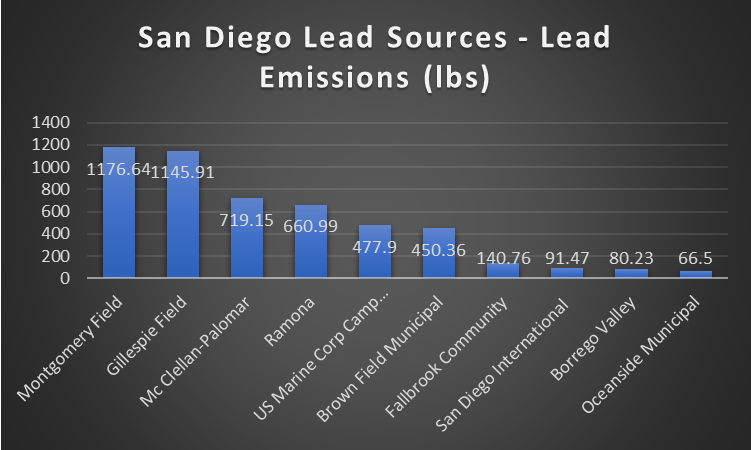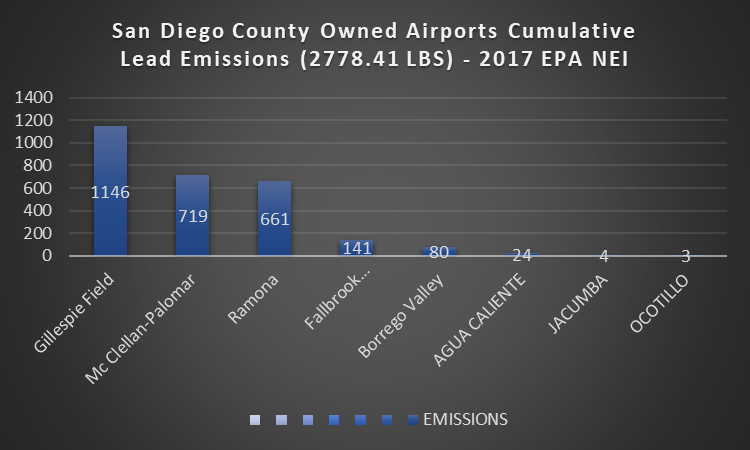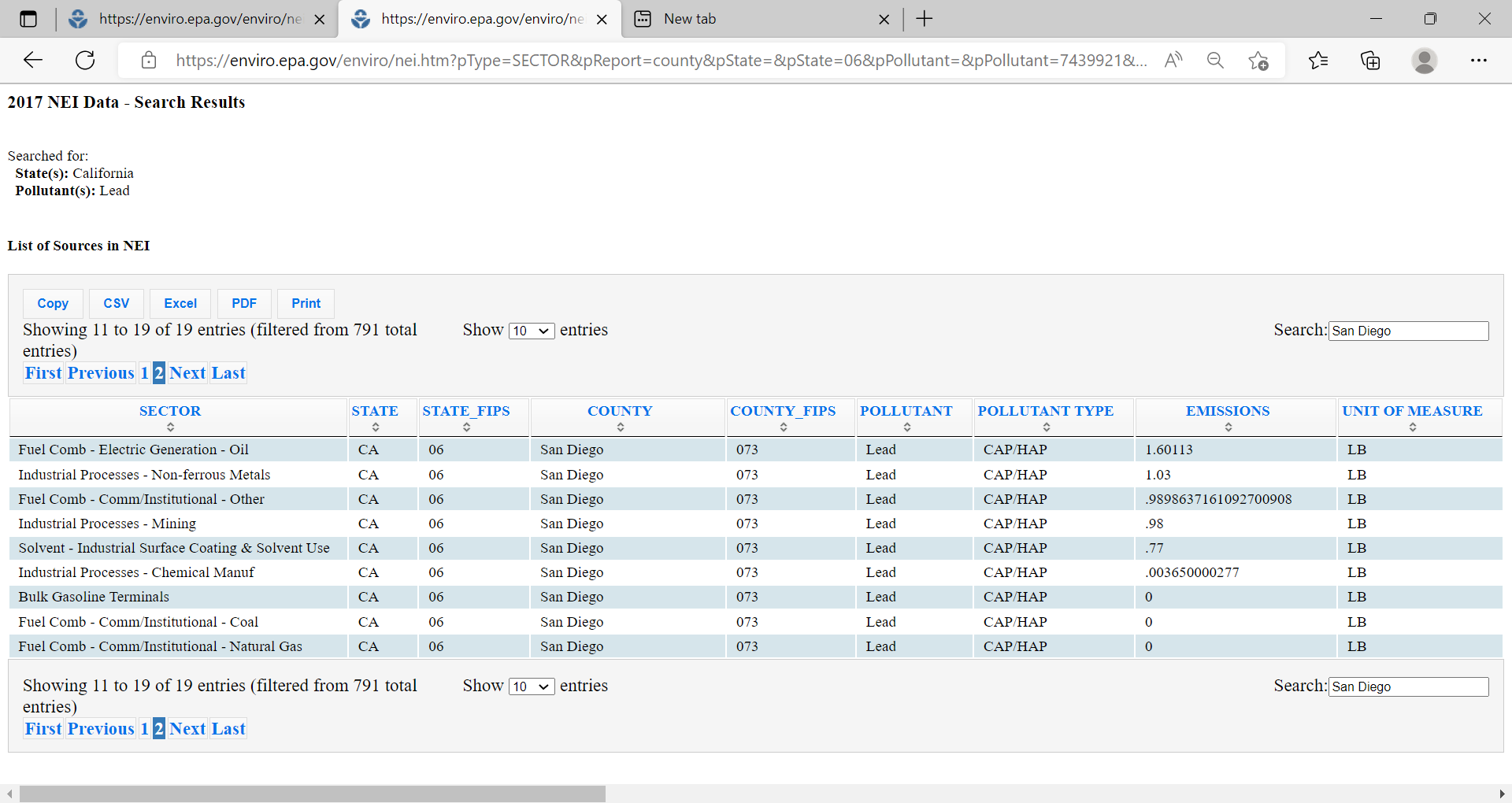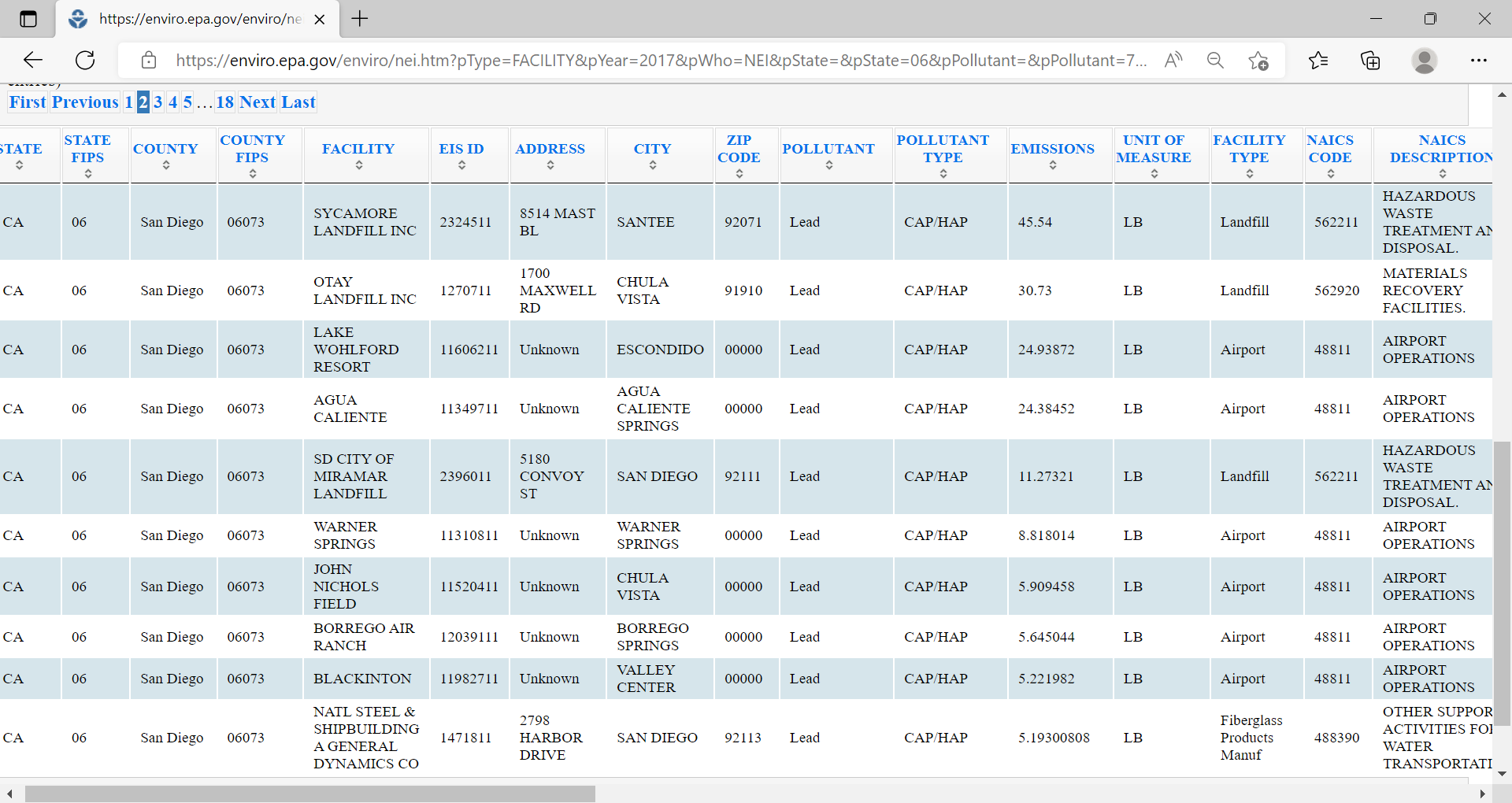San Diego County Air Pollution and Lead Emissions
This article was prepared by Miki Barnes of Oregon Aviation Watch in consultation with San Diego based Citizens Against Gillespie Expansion and Low Flying Aircraft (CAGE-LFA).
San Diego County has a history of poor air quality. The American Lung Association State of the Air 2022 report on the 25 most polluted U.S. counties in terms of ozone levels, ranked San Diego eighth. (pg. 19) In a listing of the 25 most polluted cities based on daily PM levels, the San Diego-Chula Vista-Carlsbad region was 13th. (Pg. 13) This same area came in 6th in the list of 25 cities most polluted by ozone ratings.
Following the release of a April 7, 2022 University of California San Diego study showing that California's environmental laws protect white residents from pollution over people of color, the PBS News Hour aired a story "How Air Pollution Is Disproportionately Impacting Minority Communities in San Diego." The report focused on San Diego's Barrio Logan community located next to the Port of San Diego. Seventy percent of the people who reside in this neighborhood are Hispanic. Forty percent live below the poverty level. Many are suffering from the adverse health impacts of pollution including high asthma rates, frequent bronchial infections, headaches and breathing problems due to proximity to major industrial polluters as well as pollution from heavy road traffic. Per PBS correspondent, Amna Nawaz, this area has "higher levels of diesel pollution than almost anywhere in the state of California."
San Diego County Lead Emissions
Though not discussed in the above referenced study, San Diego County residents are also heavily impacted by lead emissions released by piston-engine aircraft. Lead is a neurotoxin known to disproportionately harm children as well as minority and economically disadvantaged populations. Exposure to lead even in very small amounts is linked with IQ loss, learning and behavior problems, impulse control issues, juvenile delinquency and ADHD. In adults it is associated with higher rates of cardiovascular deaths, reproductive problems, miscarriages, kidney ailments and increased violence. The adverse impacts of lead are potentially irreversible.
A review of the 2017 Environmental Protection Agency (EPA) National Emissions Inventory (NEI) reveals that there are 180 facility sources of lead in San Diego County. Fifty-one are airports which are cumulatively responsible for releasing 4662 lbs, 2.3 tons of lead into the air every year. Nine of the top ten lead polluters are airports and one is a military base. All are tax payer subsidized facilities. Airports owned and operated by San Diego County municipalities are far and away the biggest lead polluters in this jurisdiction.
The following pie chart identifies the various sectors listed in the 2017 EPA NEI responsible for lead pollution in San Diego County—a total of 5300 lbs, 2.65 tons per year. Mobile aircraft release 88% of all lead emissions in this jurisdiction.
Lead emission data in the 2017 NEI reveals that nationwide 468 tons of lead were released into the air every year. As shown in the pie chart below, aircraft sources are responsible for seventy percent of that amount. In San Diego County, the contribution of aviation to airborne lead pollution is 18 percentage points higher than the national average.

See two 2017 EPA NEI screenshots in the Sources section for a more detailed accounting of lead emissions by sector.
Largest Facility Sources of Lead in San Diego County
The following bar chart shows the top 10 facility sources of lead emissions in San Diego County.

Two City of San Diego owned and operated airports are among the top 10 lead polluters. Montgomery-Gibbs, the largest facility source of lead in the county, pumps 1176.6 lbs of this toxin into the air every single year and Brown Field Municipal, the sixth ranked lead polluter in the county, releases 450.4 lbs of lead annually. These two city-owned airports combined release 1627 lbs, more than three-quarters of a ton, of lead into the environment each year.
Five of the eight airports owned and operated by the County of San Diego are also among the top 10 lead polluters. Gillespie Field in second place comes in at 1145.9 lbs, McClellan-Palomar ranked third emits 719.2 lbs, Ramona in fourth place releases 660.9 lbs, Fallbrook Community at 140.8 lbs is seventh, and Borrego Valley at 80.2 lbs is ninth. These five airports combined release a total of 2,747 lbs of lead into the air every year.

The Camp Pendleton Military Base in fifth place adds an additional 477.9 lbs while the San Diego International Lindberg ranked eighth, contributes 91.5 lbs. In tenth place at 66.5 lbs of lead emissions is Oceanside Municipal which according to the FAA is owned by the City of Oceanside.
These 10 sources alone release 5009.9 lbs, more than two-and-one-half tons, of lead into the air every single year.
It is also worth noting that four of the airports discussed above—Montgomery-Gibbs, Gillespie Field, McClellan Palomar and Ramona—are among the top 50 lead polluting airports in the U.S.
Closing Comments
So how do the county supervisors, city council members, mayors and government entities reconcile their promotion and advocacy for these toxic airports with their responsibility to protect the health and well-being of the greater population, especially knowing that these facilities produce a number of adverse health impacts due to lead emissions, heightened ozone levels, noise and other pollutants?
Only one of San Diego County's 51 airports provides scheduled commercial airline passenger service—San Diego International. Though a source of PM2.5 and ozone, jets do not use leaded aviation fuel. However, the piston-engine aircraft that fly in and out of these facilities do. The major lead polluters in San Diego County are general aviation airports that primarily serve the interests of flight training schools, private pilots, charter companies, air taxis, corporate jets and other for-profit aviation businesses. They exist to serve an affluent few—the less than one-quarter of one percent of the U.S. population certified to pilot piston-engine aircraft. The vast majority of people living in San Diego County do not use these highly polluting municipality owned and operated airports. They are, however, negatively impacted by the pollutants produced by the aircraft flying in and out of these facilities. Sources
EPA NEI 2017 – San Diego County Lead Emissions by Sector


EPA NEI 2017 – Top 20 Lead Emission Facility Sources in San Diego County. Fifteen, 75%, are airports.


| © Oregon Aviation Watch | Contact Us |  Jump to Top Jump to Top |
